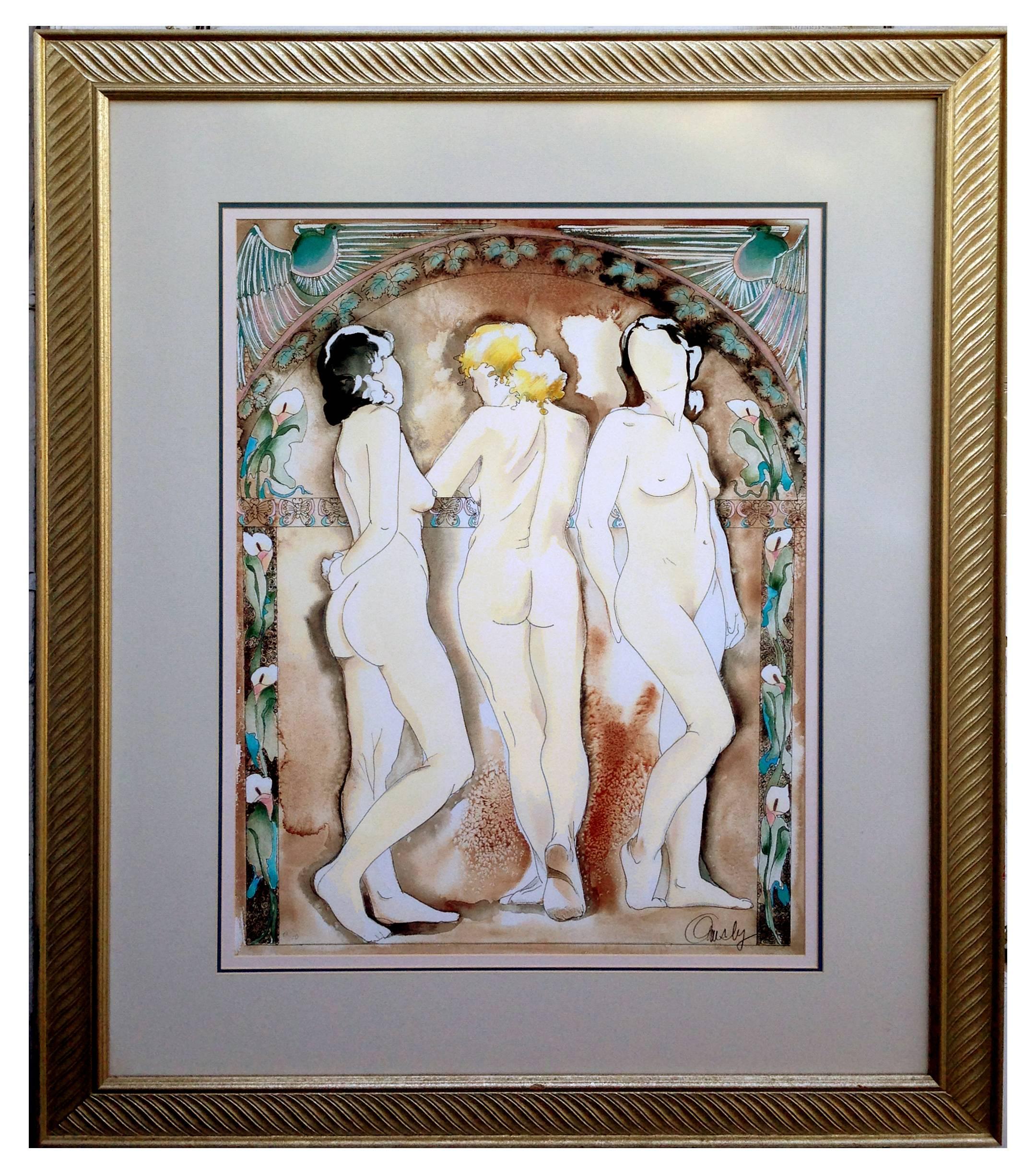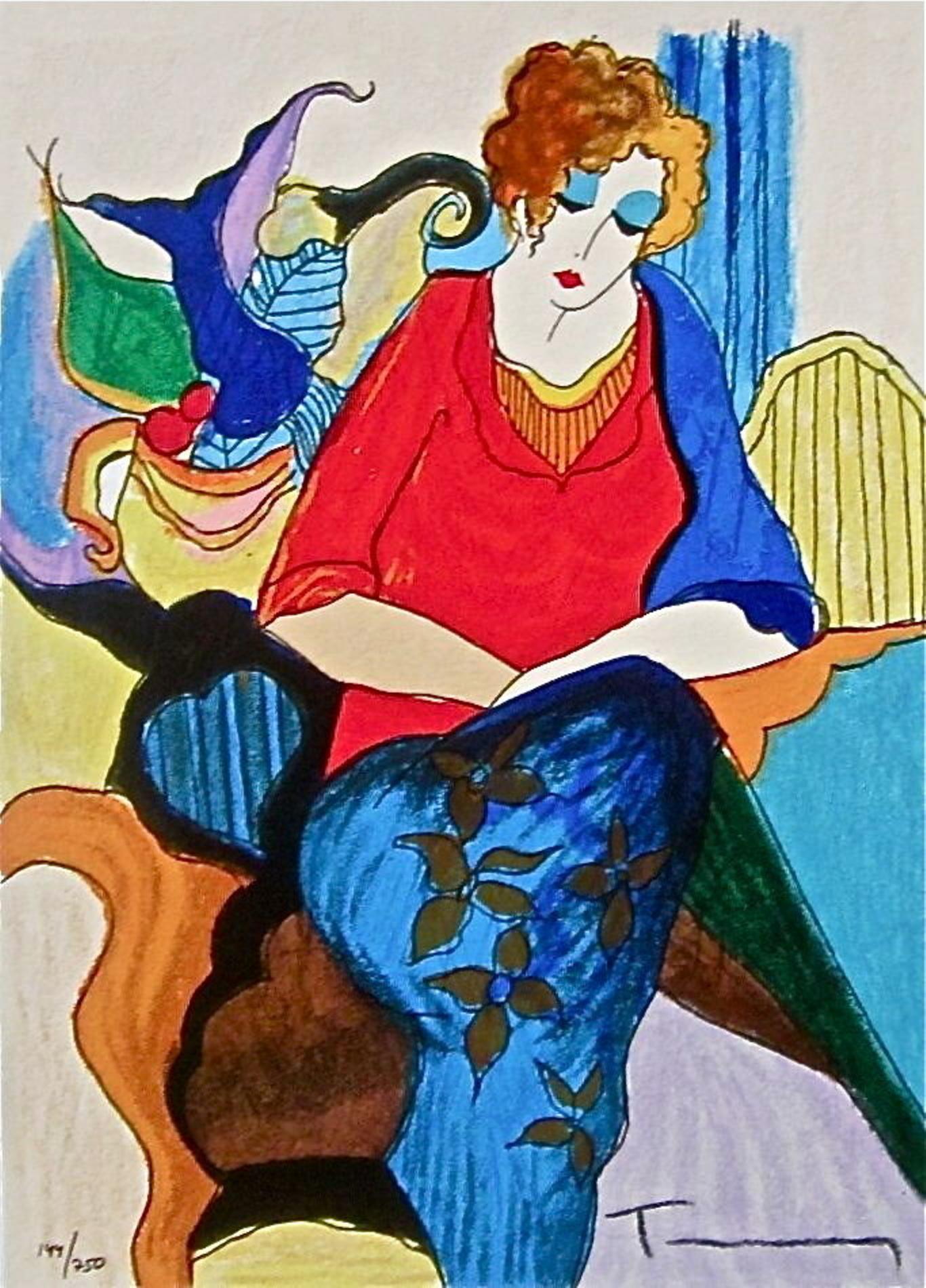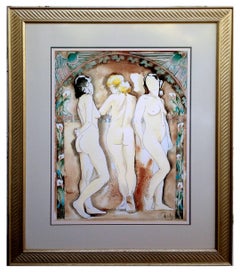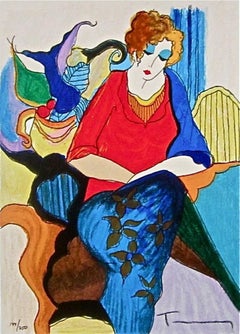Want more images or videos?
Request additional images or videos from the seller
1 of 11
Barbara A. WoodIntermission1995
1995
$1,250
£971.04
€1,101.79
CA$1,787.26
A$1,955.31
CHF 1,021.22
MX$23,366.44
NOK 12,830.26
SEK 12,075.30
DKK 8,228
About the Item
This artwork "Intermission" 1995 is an original colors serigraph by American artist Barbara A. wood, born 1926. It is hand signed and numbered 251/350 in pencil by the artist. The artwork (image) size is 16.25 x 16.25 inches, framed size is 28.5 x 28.5 inches. It is custom framed in a gold frame, with black matting and gold color fillet. It is in excellent condition, the frame have some minor restorations at the lower left corner, barely visible.
Barbara A. Wood is a native of Ohio. She attended school in Toledo and graduated from high school with a scholarship to Traphagen School of Fashion in New York. Her instructors found her work so creative and expressive that they encouraged her to pursue fine arts.She enrolled and completed her formal studies at the famous Art Students’ League in New York. She moved to Southern California where she began postgraduate studies at the Otis Art Institute and the Pasadena School of Fine Arts.
Internationally known, she has had major one-person shows throughout the United States, Australia, Canada, and London. Her works are part of the collections of numerous celebrities as well as private collections throughout the world. Her paintings are in the collections of His Majesty the King of Saudi Arabia’s Private Office, President George H. W. Bush, Georgia Governor Sonny Perdue, Elizabeth Taylor, Hugh Hefner, Jane Seymour, Jerry Lewis, Mickey Rooney, Dick Van Dyke, Dennis Weaver, Art Linkletter, Ron Howard, Gavin MacLeod, and many others.
- Creator:Barbara A. Wood (1926, American)
- Creation Year:1995
- Dimensions:Height: 28.5 in (72.39 cm)Width: 28.5 in (72.39 cm)Depth: 1.25 in (3.18 cm)
- Medium:
- Movement & Style:
- Period:
- Condition:
- Gallery Location:San Francisco, CA
- Reference Number:Seller: woo/int/011stDibs: LU666314028832
Barbara A. Wood
Barbara A. Wood (American, b. 1926) was born and raised in Columbus, Ohio. Raised by her mother, grandmother, and great-grandmother, the personalities and hardships within each woman became the catalyst for her art. As an only child and quite often bedridden with bouts of pneumonia, Barbara spent most of her time painting alone. She attended school in Toledo and graduated from high school with a scholarship to Traphagen School of Fashion in New York. Her instructors found her work so creative and expressive that they encouraged her to pursue fine arts. She enrolled and completed her formal studies at the Art Students League in New York. She later married and moved to Southern California. She began postgraduate studies at the Otis Art Institute and the Pasadena School of Fine Arts. Wood has had major one-person shows throughout the United States, Australia, Canada, and London. Her works are part of the collections of numerous celebrities as well as private collections throughout the world. Her paintings are in the collections of the King of Saudi Arabia, President George H. W. Bush, Georgia Governor Sonny Perdue, Elizabeth Taylor, Hugh Hefner, Jane Seymour, Jerry Lewis, Mickey Rooney, Dick Van Dyke, Dennis Weaver, Art Linkletter, Ron Howard, Gavin MacLeod, and many others. Artist’s Statement: Painting, to me, is a joy, a challenge, a fulfillment, and a love affair. It is a vehicle for expressing impressions I have drawn from a tangible world, where color is the music of painting.
About the Seller
5.0
Platinum Seller
Premium sellers with a 4.7+ rating and 24-hour response times
Established in 1999
1stDibs seller since 2017
854 sales on 1stDibs
Typical response time: 1 hour
- ShippingRetrieving quote...Shipping from: San Francisco, CA
- Return Policy
More From This Seller
View AllPensive Woman
By Barbara A. Wood
Located in San Francisco, CA
This artwork Titled "Pensive Woman" is an original seriolithograph (serigraph with lithograph) by American artist Barbara A. wood, born 1926. It is hand ...
Category
Late 20th Century Modern Figurative Prints
Materials
Other Medium
Woman Sitting
By Barbara A. Wood
Located in San Francisco, CA
This artwork "Woman Sitting" c.1990 is an offset lithograph by American artist Barbara A. wood, born 1926. It is hand signed and numbered 222/975 in penc...
Category
Late 20th Century Modern Figurative Prints
Materials
Lithograph
Expanding
By Betty Rees Heredia
Located in San Francisco, CA
This artwork titled "Expandingr" 2001 is a original color lithograph on wove paper by American artist Betty Rees Heredia A.K.A Betty Snyder Shapiro,...
Category
Late 20th Century American Modern Abstract Prints
Materials
Lithograph
At The Park
By Barbara A. Wood
Located in San Francisco, CA
This artwork titled "At The Park" Circa 1980 is an offset lithograph on Wove paper by artist Barbara A. Wood (American) It is signed and numbered 356/875 in pencil by the artist. The...
Category
Late 20th Century Modern Figurative Prints
Materials
Offset
Untitled II
By Alvar Sunol Munoz-Ramos
Located in San Francisco, CA
This artwork "Untitled II" is an original color lithograph with embossing by noted Spanish artist Alvar Sunol Munoz Ramos, b.1935. It is hand signed and numbered 101/260 in pencil by...
Category
Late 20th Century Modern Figurative Prints
Materials
Lithograph
Confiding
By Itzchak Tarkay
Located in San Francisco, CA
This artwork titled "Confiding" 2008 is an original color serigraph on Wove paper by Israeli artist Itzchac Tarkay 1935-2012. It is hand signed and numbered E.A 63/80 in pencil by t...
Category
Late 20th Century Art Deco Figurative Prints
Materials
Screen
You May Also Like
"The Aunties" - Figurative Abstract Limited Edition Print, 20/100
By Anne Ormsby
Located in Soquel, CA
Beautiful figurative giclée and watercolor limited edition print titled "The Aunties", a homage to the classical figurative sculpture The Three Graces, by Anne Ormsby, a Aptos, Calif...
Category
1990s American Impressionist Figurative Prints
Materials
Paper, Watercolor, Giclée
$1,240 Sale Price
20% Off
Waiting, Itzchak Tarkay
By Itzchak Tarkay
Located in Fairfield, CT
Artist: Itzchak Tarkay (1935-2012)
Title: Waiting
Year: Circa 2000
Medium: Silkscreen on wove paper
Size: 13.5 x 10.75 inches
Edition: 750, plus 100 Remarques
Condition: Excellent
In...
Category
Early 2000s American Impressionist Figurative Prints
Materials
Screen
$796 Sale Price
20% Off
"Admired"
By Gershon Benjamin
Located in Lambertville, NJ
Jim’s of Lambertville is proud to offer this artwork by:
Gershon Benjamin (1899-1985)
An American Modernist of portraits, landscapes, still lives, and the urban scene, Gershon Ben...
Category
1940s Modern Figurative Drawings and Watercolors
Materials
Graphite
Ballerina at Intermission
By Francois Cloutier
Located in Fort Washington, PA
Image of a ballerina wearing a tutu sitting in front of a brick wall.
Signed Lower Left.
Artist Francois Cloutier captures the essence of ballet in paintings of dancers who maintai...
Category
20th Century Other Art Style Figurative Paintings
Materials
Canvas, Oil
Noon Hour
By Isabel Bishop
Located in Westport, CT
Noon Hour. 1935. Etching. Teller 18. 6 7/8 x 4 7/8 (sheet 11 3/8 x 8 1/2). Edition 250 published by Associated American Artists in 1946 (were a few earlier impressions from a propose...
Category
Early 20th Century American Modern Figurative Prints
Materials
Etching
Dream Mystique
By Wallace Bassford
Located in Lake Worth Beach, FL
Dream Mystique
Artist signed and titled, new frame canvas 24x20
Wallace Bassford was an American painter and illustrator, born in 1900 in St. Louis Missouri, he attended the St. Loui...
Category
1970s Expressionist Figurative Paintings
Materials
Oil, Canvas
More Ways To Browse
Dick Van Dyke
The Avengers
Triple Self Portrait
Vitraux Pour Jerusalem
Walasse Ting Geisha
Wayland Moore
Whitney Poster
Yoshitoshi Taiso
1930s Woodblock
Ai Weiwei Tree
Alice And Wonderland Salvador Dali
Andre Heller
Andy Warhol Invitation
Angel Zarraga
Antique Boat Motors
Antique Mermaid Print
Bonnard Etching
Carlos Bastos



